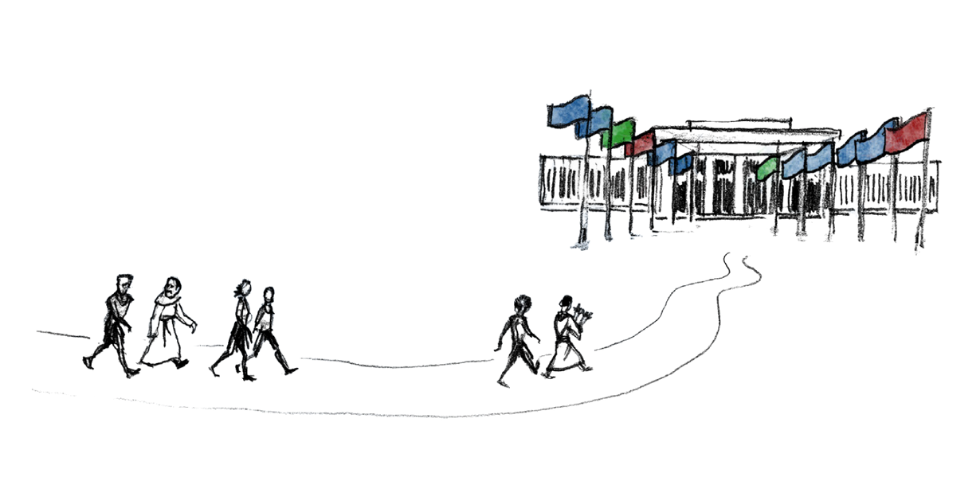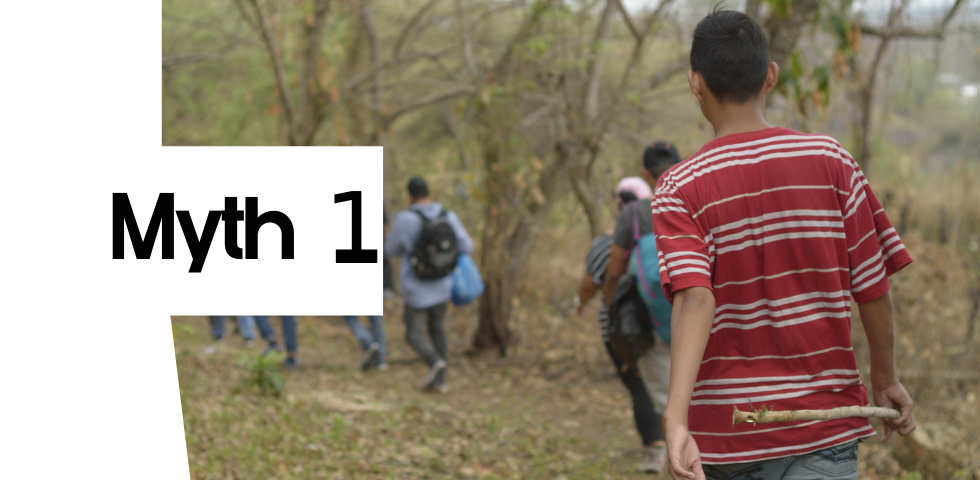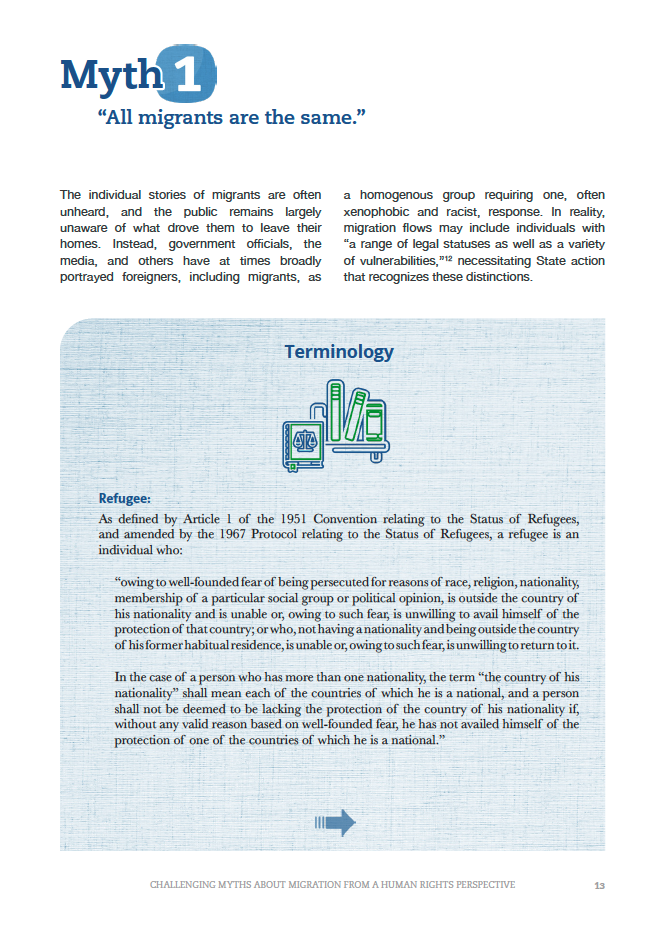“All migrants are the same”
The individual stories of migrants are often unheard, and the public remains largely unaware of what drove them to leave their homes. Instead, government officials, the media, and others have at times broadly portrayed foreigners, including migrants, as a homogenous group requiring one, often xenophobic and racist, response.
In reality, migration flows may include individuals with “a range of legal statuses as well as a variety of vulnerabilities, necessitating State action that recognizes these distinctions.

Terminology
Refugee
As defined by Article 1 of the 1951 Convention relating to the Status of Refugees, and amended by the 1967 Protocol relating to the Status of Refugees, a refugee is an individual who:
“owing to well-founded fear of being persecuted for reasons of race, religion, nationality, membership of a particular social group or political opinion, is outside the country of his nationality and is unable or, owing to such fear, is unwilling to avail himself of the protection of that country; or who, not having a nationality and being outside the country of his former habitual residence, is unable or, owing to such fear, is unwilling to return to it.
In the case of a person who has more than one nationality, the term “the country of his
nationality” shall mean each of the countries of which he is a national, and a person shall not be deemed to be lacking the protection of the country of his nationality if, without any valid reason based on well-founded fear, he has not availed himself of the
protection of one of the countries of which he is a national.”
In 1984, the Cartagena Declaration on Refugees sought to extend the definition to include “persons who have fled their country because their lives, safety or freedom have been threatened by generalized violence, foreign aggression, internal conflicts, massive violation of human rights or other circumstances which have seriously disturbed public order.”[i] The Declaration is non-binding, but has been incorporated into the national laws of States across Latin America and has become an example of regional customary law.
[i] Cartagena Declaration on Refugees, Colloquium on the International Protection of Refugees in Central America, Mexico and Panama, adopted by the Colloquium on the International Protection of Refugees in Central America, Mexico and Panama, held at Cartagena, Colombia from 19 – 22 November 1984, para. 3, available at https://www.oas.org/dil/1984_cartagena_ declaration_on_refugees.pdf
Asylum-seeker
an individual who is outside of their home country and is “seeking international protection,”[i] a process which may result in the attainment of refugee status.
[i] UNHCR Global Report 2005, United Nations High Commissioner for Refugees (UNHCR), p.441, available at https:// www.unhcr.org/449267670.pdf
Internally Displaced Person (IDP)
An individual that has been forced to flee his home but remains within the borders of their country of residence.
Migrants
In lieu of a legal definition, UN agencies and entities have included varying categories of persons, including the aforementioned, under the term ‘migrant’ in line with their mandates.
The Office of the High Commissioner for Human Rights (OHCHR) defines international migrants as “any person who is outside a State of which he or she is a citizen or national, or, in the case of a stateless person, his or her State of birth or habitual residence. The term includes migrants who intend to move permanently or temporarily, and those who move in a regular or documented manner as well as migrants in irregular situations.”[i]
The United Nations High Commissioner for Refugees (UNHCR) distinguishes migrants from refugees by asserting that a migrant is “best understood as someone who chooses to move, not because of a direct threat to life or freedom, but in order to find work, for education, family reunion, or other personal reasons. Unlike refugees, migrants do not have a fear of persecution or serious harm in their home countries. Migrants continue to enjoy the protection of their own governments even when abroad and can return home.”[ii]
The World Health Organization (WHO) includes those that are forcibly displaced as internal or international migrants.[iii]
The UN Working Group on Arbitrary Detention, in its revised deliberation No. 5 on deprivation of liberty of migrants, defined “migrant” as “any person who is moving or has moved across an international border away from his or her habitual place of residence, regardless of: (a) the person’s legal status; (b) whether the movement is voluntary or involuntary; (c) the cause of the movement; or (d) the duration of stay. The term shall also be taken to include asylum seekers, refugees and stateless persons.”[iv]
The UN International Organization for Migration (IOM) also distinguishes internal migrants, which may include internally displaced persons, as well as individuals “who decide to move to a new place” within a State “such as in the case of rural-urban migration.”[v]
Considering these divergences, the Special Rapporteur on human rights defenders has noted “the narrow categories of ‘migrant’ and ‘refugee’, and the silos of policy and activism that they perpetuate,” and adopted the term “people on the move” in his report on human rights defenders and migration.[vi]
Indeed, the varying definitions used by UN agencies underscores the need for States to develop holistic approaches, while recognizing their obligations to protect refugees and asylum-seekers. This includes the principle of non-refoulement, under the 1951 Refugee Convention, whereby States are prohibited from expelling or returning (‘refouler’) “a refugee in any manner whatsoever to the frontiers of territories where his life or freedom would be threatened on account of his race, religion, nationality, membership of a particular social group or political opinion.”[vii] Central to current issues surrounding migration and the closing of borders, alongside other repressive policies, is that individuals seeking asylum, who have not gone through an official refugee status determination process, remain protected by the principle of non-refoulement, with limited exceptions.[viii]
UN agencies have noted that all migrants and refugees may be “disproportionately vulnerable to exclusion, stigma and discrimination, particularly when undocumented.”[ix] However, particular subsets of individuals, including indigenous peoples, unaccompanied minors, and women may have an increased risk to human rights abuses, including due to state policies and also the actions of non-state actors.[x]
For example, when visiting the Philippines in 2016, the UN Special Rapporteur on the rights of internally displaced persons noted that “armed conflict and extractive and logging activities on indigenous ancestral territories have a devastating impact on indigenous peoples (Lumads), displacing them and subjecting them to gross violation of their rights and to conditions that threaten their unique communities, cultures and lifestyles.”[xi]
[i] Recommended Principles and Guidelines on Human Rights at International Borders, UN Office of the High Commissioner for Human Rights (OHCHR), Footnote 2, available at https://www. ohchr.org/Documents/Issues/Migration/OHCHR_Recommended_ Principles_Guidelines.pdf
[ii] A Guide to International Refugee Protection and Building State Asylum Systems, Handbook for Parliamentarians N° 27, UNHCR, 2017, p.
[iii] available at https://www.unhcr. org/3d4aba564.pdf 17 The WHO organization for example notes “An estimated 70.8 million of the world’s internal and international migrants are forcibly displaced today.” See: Refugee and migrant health, World Health Organization, available at https://www.who.int/healthtopics/refugee-and-migrant-health#tab=tab_1
[iv] Revised deliberation No. 5 on deprivation of liberty of migrants, para. 6, Annexed to Report of the Working Group on Arbitrary Detention, 2 July 2018, A/HRC/39/45, available at https://documents-dds-ny.un.org/doc/UNDOC/GEN/G18/196/69/ PDF/G1819669.pdf?OpenElement
[v] Key Migration Terms, UN International Organization for Migration, available at https://www.iom.int/key-migration-terms
[vi] Report of the Special Rapporteur on the situation of human rights defenders, 16 January 2018, A/HRC/37/51, para.2
[vii] 1951 Convention Relating to the Status of Refugees (The Refugee Convention), Article 33(1), available at https://www. unhcr.org/4ca34be29.pdf
[viii] Id. Article 33(2) outlines exceptions are limited to where there are reasonable grounds to regard an individual “as a danger to the security of the country in which he is, or who having been convicted by a final judgment of a particularly serious crime, constitutes a danger to the community of that country.” See also: A guide to international refugee protection and building state asylum systems, Handbook for Parliamentarians N° 27, 2017, UNHCR, p.20, available at https://www.unhcr.org/3d4aba564.pdf
[ix] OHCHR, IOM, UNHCR and WHO Joint Press Release: the rights and health of refugees, migrants and stateless must be protected in COVID-19 response, 31 March 2020, available at https://www.who.int/news-room/detail/31-03-2020-ohchr-iomunhcr-and-who-joint-press-release-the-rights-and-health-of
[x] See for example: End of mission statement by Dubravka Šimonović, United Nations Special Rapporteur on Violence against women, its causes and consequences – Official visit to Canada, which notes concerns regarding female migrants facing violence and access to State services and assistance. 23 April 2018, available at https://www.ohchr.org/en/NewsEvents/Pages/ DisplayNews.aspx?NewsID=22981&LangID=E
[xi] UN Special Rapporteur on the human rights of internally displaced persons, Report on his mission to the Philippines, April 2016, A/HRC/32/35/Add.3, p.1, available at https:// documents-dds-ny.un.org/doc/UNDOC/GEN/G16/068/60/PDF/ G1606860.pdf?OpenElement

Franciscans International, the NGO of the Franciscan Family to the United Nations, has prepared this material. The publication presented in this post is an extract from the document “Breaking down the Walls, Myth 1: All Migrants are the same,” you can do it here ↓


